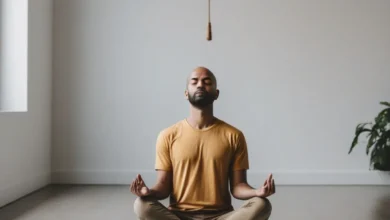7-Day Morning Mindfulness Challenge: A Daily Routine for Peace

I. Introduction
Did you know that how you start your morning can set the tone for your entire day? Imagine waking up feeling calm, focused, and ready to tackle whatever comes your way. That’s the power of a morning mindfulness routine.
Welcome to our “7-Day Morning Mindfulness Challenge: A Daily Routine for Peace.” This week-long journey is designed to help you kickstart your day with purpose and tranquility. By dedicating just a few minutes each morning to mindfulness practices, you can transform your daily experience and cultivate lasting inner peace.
Here’s what you can expect from this challenge:
- Simple, easy-to-follow daily practices
- A gradual introduction to various mindfulness techniques
- Increased awareness and focus throughout your day
- Better stress management and emotional balance
- A greater sense of overall well-being
Are you ready to start your mornings with intention and end your days feeling more peaceful? Let’s embark on this 7-day mindfulness challenge together and discover the positive impact it can have on your life.
II. Preparing for the Challenge

Before we dive into our 7-day morning mindfulness routine, let’s set ourselves up for success. Proper preparation can make a big difference in how much you benefit from this challenge.
A. Setting intentions and goals
Take a moment to think about why you’re starting this challenge. Are you looking to:
- Reduce stress?
- Improve focus?
- Find more joy in your daily life?
Write down your top 1-2 goals for this week. Having clear intentions will help you stay motivated and track your progress.
B. Creating a dedicated space for practice
Choose a quiet, comfortable spot in your home for your morning mindfulness practice. This could be:
- A corner of your bedroom
- A cozy chair in the living room
- A peaceful outdoor space, like a balcony or garden
Make this space inviting with items that promote calm, such as:
- Soft cushions or blankets
- A candle or essential oil diffuser
- Plants or nature-inspired décor
C. Tips for consistency and commitment
- Set a daily alarm 10-15 minutes earlier than usual to make time for your practice.
- Place a reminder (like a sticky note or small object) on your nightstand or bathroom mirror.
- Tell a friend or family member about your challenge for accountability.
- Prepare any materials you’ll need the night before (like a journal or yoga mat).
- Start small – even 5 minutes of practice is beneficial!
Remember, the key to building a lasting morning mindfulness routine is consistency, not perfection. Be patient and kind with yourself as you begin this journey.
III. The 7-Day Morning Mindfulness Challenge
Day 1: Mindful Breathing

Let’s start our morning mindfulness routine with a simple yet powerful practice: mindful breathing.
Explanation of the breathing technique:
Mindful breathing involves focusing your attention on your breath as it moves in and out of your body. This practice helps anchor you to the present moment, calming your mind and body.
Step-by-step guide for a 5-minute practice:
- Find a comfortable seated position in your dedicated space.
- Close your eyes or softly gaze downward.
- Take a deep breath in through your nose for 4 counts.
- Hold your breath for 2 counts.
- Exhale slowly through your mouth for 6 counts.
- Repeat this cycle for 5 minutes.
- If your mind wanders, gently bring your focus back to your breath without judgment.
Benefits of mindful breathing:
- Reduces stress and anxiety
- Improves focus and concentration
- Lowers heart rate and blood pressure
- Enhances emotional regulation
- Promotes a sense of calm to start your day
Remember, the goal isn’t to clear your mind completely, but to practice returning to your breath when thoughts arise. This simple act of refocusing is at the heart of mindfulness.
Pro tip: If you find it challenging to focus on your breath, try counting each inhale and exhale, or placing a hand on your belly to feel the rise and fall.
By starting your day with this 5-minute breathing practice, you’re setting a foundation for a more mindful and peaceful day ahead.
Day 2: Body Scan Meditation
Today, we’ll explore a body scan meditation as part of our morning mindfulness routine. This practice helps you connect with your body and release tension you might not even realize you’re holding.
Instructions for a full body scan:
- Lie down comfortably on your back or sit in a relaxed position.
- Close your eyes and take a few deep breaths to settle in.
- Begin at your toes, focusing your attention on how they feel.
- Slowly move your attention upward, through your feet, ankles, legs, and so on.
- Notice any sensations in each body part without trying to change them.
- If you encounter tension, breathe into that area and imagine it softening.
- Continue until you reach the top of your head.
- Finally, become aware of your body as a whole.
How to incorporate it into your morning routine:
- Set aside 10-15 minutes after waking up for this practice.
- Use a guided body scan recording if you find it helpful.
- Start with shorter scans (5 minutes) and gradually increase the duration.
Physical and mental benefits:
- Improved body awareness
- Reduced physical tension
- Better sleep quality
- Enhanced mind-body connection
- Increased ability to manage pain
- Greater overall relaxation
The body scan is a powerful tool for bringing mindfulness into your physical experience. It can help you start your day feeling more grounded and in tune with yourself.
Remember: It’s normal for your mind to wander during this practice. When you notice this happening, gently guide your attention back to the part of the body you were focusing on.
By practicing the body scan regularly, you’re developing a valuable skill for daily peace and well-being. You might be surprised at how much calmer and more centered you feel as you go about your day.
Day 3: Gratitude Journaling

Today, we’ll incorporate gratitude journaling into our morning mindfulness routine. This practice helps shift your focus to the positive aspects of your life, setting a tone of appreciation for the day ahead.
Guide to starting a gratitude journal:
- Choose a journal or notebook that you enjoy using.
- Set aside 5-10 minutes each morning for this practice.
- Write down 3-5 things you’re grateful for, big or small.
- Be specific and try to include different things each day.
- Reflect on why you’re grateful for each item.
Prompts for morning gratitude practice:
- What’s something beautiful you saw recently?
- Who is someone you appreciate having in your life?
- What’s a recent accomplishment you’re proud of?
- What’s a simple pleasure you enjoy?
- What’s something you’re looking forward to today?
How gratitude enhances mindfulness and peace:
- Shifts focus from what’s lacking to what’s present
- Increases positive emotions and life satisfaction
- Reduces stress and improves mental health
- Enhances empathy and reduces aggression
- Improves self-esteem and resilience
- Helps build stronger relationships
Pro tip: If you’re struggling to think of things to be grateful for, start with the basics – your health, a roof over your head, or access to clean water. Gratitude for these fundamental aspects of life can be powerful.
Remember, the goal isn’t to ignore life’s challenges, but to balance your perspective by acknowledging the good alongside the difficult. This practice can significantly contribute to your daily peace and overall well-being.
As you go through your day, try to notice moments of gratitude as they arise. This mindful awareness can help extend the benefits of your morning practice throughout the day.
Day 4: Mindful Movement

Today, we’re adding gentle movement to our morning mindfulness routine. This practice combines physical activity with mental focus, helping you start your day feeling energized and centered.
Introduction to gentle morning stretches or yoga:
Mindful movement involves performing simple stretches or yoga poses while maintaining awareness of your body and breath. This practice helps wake up your body, increase flexibility, and focus your mind.
Simple sequence of movements:
- Mountain Pose: Stand tall, feet hip-width apart. Feel grounded and breathe deeply.
- Arm Raises: Inhale, raise arms overhead. Exhale, lower them. Repeat 5 times.
- Side Bends: Inhale, raise right arm. Exhale, bend to the left. Alternate sides 5 times.
- Forward Fold: Exhale, bend forward from the hips. Hold for 3 breaths.
- Cat-Cow: On hands and knees, alternate arching and rounding your back with breath.
- Child’s Pose: Rest in this pose for 5 deep breaths.
Connecting movement with breath for increased mindfulness:
- Sync your movements with your breath.
- Notice how each movement feels in your body.
- Pay attention to any sensations or areas of tension.
- If your mind wanders, gently bring it back to your breath and movement.
Benefits of mindful movement:
- Improves body awareness
- Increases energy and alertness
- Reduces physical tension and stress
- Enhances focus for the day ahead
- Promotes a mind-body connection
Remember: This practice isn’t about perfecting poses or pushing your limits. It’s about moving with awareness and treating your body with kindness.
Pro tip: If you’re short on time, even 5 minutes of mindful stretching can make a difference in how you feel throughout the day.
By incorporating mindful movement into your morning routine, you’re giving yourself a chance to check in with your body and set a positive tone for the day.
Day 5: Mindful Eating Breakfast

Today, we’ll focus on bringing mindfulness to our morning meal. Practicing mindful eating can transform a rushed breakfast into a moment of peace and nourishment.
Techniques for eating breakfast mindfully:
- Sit down at a table without distractions (no phone or TV).
- Take a moment to observe your food before eating.
- Take small bites and chew slowly.
- Pay attention to the taste, texture, and aroma of your food.
- Notice your body’s signals of hunger and fullness.
Sensory awareness exercise during eating:
- Look: Observe the colors and shapes on your plate.
- Smell: Take in the aroma of your food before tasting.
- Touch: Feel the temperature and texture of the food in your mouth.
- Taste: Notice the different flavors as you chew.
- Listen: Pay attention to the sounds of eating (crunching, sipping).
Benefits of mindful eating for overall well-being:
- Improves digestion
- Enhances enjoyment of food
- Reduces overeating and emotional eating
- Increases awareness of hunger and fullness cues
- Promotes a healthier relationship with food
- Reduces stress associated with mealtimes
Pro tip: If you’re short on time, even practicing mindful eating for the first few bites of your meal can make a difference.
Remember, mindful eating isn’t about eating perfectly or following strict rules. It’s about bringing awareness to the experience of nourishing your body. This practice can help you start your day with a sense of calm and gratitude.
Bonus challenge: Try preparing your breakfast mindfully too. Notice the colors of the ingredients, the sounds of cooking, and the aromas that fill your kitchen.
By incorporating mindful eating into your morning routine, you’re not just nourishing your body, but also cultivating peace and presence at the start of your day.
Day 6: Loving-Kindness Meditation
Today, we’ll explore loving-kindness meditation, also known as metta meditation. This practice helps cultivate feelings of goodwill towards yourself and others, fostering a sense of connection and inner peace.
Explanation of loving-kindness (metta) meditation:
Loving-kindness meditation involves directing positive wishes or intentions towards yourself and others. It’s a way to develop compassion, empathy, and a sense of goodwill that can positively impact your interactions throughout the day.
Step-by-step guide for a morning practice:
- Sit comfortably with your eyes closed.
- Take a few deep breaths to center yourself.
- Begin by directing loving-kindness to yourself. Silently repeat:
• “May I be happy”
• “May I be healthy”
• “May I be safe”
• “May I live with ease” - Next, think of a loved one and direct these wishes to them.
- Then, think of a neutral person (someone you neither like nor dislike) and repeat the phrases.
- If you’re comfortable, direct these wishes to a difficult person in your life.
- Finally, extend these wishes to all beings everywhere.
How it cultivates inner peace and compassion:
- Increases positive emotions towards self and others
- Reduces negative emotions like anger and resentment
- Enhances empathy and social connection
- Decreases self-criticism and boosts self-compassion
- Promotes a sense of interconnectedness with others
- Cultivates a more positive outlook on life
Remember: It’s normal if this practice feels awkward or challenging at first. The goal is to cultivate the intention of kindness, not to force feelings that aren’t there.
Pro tip: If you find it difficult to direct loving-kindness to others, start by focusing on yourself or a beloved pet. As you become more comfortable, gradually expand your circle of compassion.
By including loving-kindness meditation in your morning mindfulness routine, you’re setting an intention of goodwill that can influence your interactions and experiences throughout the day.
Day 7: Mindful Goal Setting
On our last day, we’ll focus on mindful goal setting. This practice helps you approach your daily tasks and long-term aspirations with intention and clarity, contributing to your overall sense of peace and purpose.
Technique for setting daily intentions mindfully:
- Find a quiet moment in your morning routine.
- Take a few deep breaths to center yourself.
- Ask yourself: “What matters most today?”
- Choose 1-3 priorities for the day.
- For each priority, set a clear, achievable intention.
- Write these intentions down in a journal or planner.
Incorporating visualization into goal setting:
- Close your eyes and imagine yourself successfully completing each intention.
- Visualize how you’ll feel when you achieve your goals.
- Picture potential obstacles and how you’ll overcome them.
How mindful goal setting impacts daily peace and productivity:
- Reduces overwhelm by focusing on what’s truly important
- Increases motivation and sense of purpose
- Improves time management and decision-making
- Enhances self-awareness of your values and priorities
- Promotes a sense of accomplishment at the end of the day
- Decreases stress related to unfulfilled expectations
Pro tip: Frame your intentions positively. Instead of “Don’t procrastinate,” try “I will start my project with focus and energy.”
Remember, the key is to approach goal setting with mindfulness and self-compassion. Be realistic with your expectations and kind to yourself if things don’t go exactly as planned.
Bonus practice: At the end of the day, take a few minutes to reflect on your intentions. Acknowledge what you accomplished and what you learned, rather than dwelling on what didn’t get done.
By incorporating mindful goal setting into your morning routine, you’re creating a roadmap for a more focused, purposeful, and peaceful day.
IV. Tips for Sustaining Your Morning Mindfulness Practice
Now that you’ve completed the 7-day challenge, let’s look at how to make mindfulness a lasting part of your mornings.
A. Strategies for overcoming common obstacles
- Lack of time:
• Start with just 5 minutes a day
• Wake up slightly earlier if possible
• Combine practices (e.g., mindful breathing while showering) - Inconsistency:
• Set a daily reminder on your phone
• Create a visual cue in your bedroom (like a meditation cushion)
• Track your practice in a habit-tracking app or journal - Mind wandering:
• Remember, noticing your wandering mind is part of the practice
• Use guided meditations to stay focused
• Start again without judgment whenever you notice your mind has wandered
B. Adapting practices to fit your schedule
- Rotate different practices throughout the week
- Shorten or lengthen sessions based on your available time
- Combine practices (e.g., gratitude journaling after body scan)
C. Combining different techniques
Here’s a table with examples of how to mix and match practices:
| Time Available | Possible Combination |
|---|---|
| 5 minutes | Mindful breathing + One gratitude entry |
| 10 minutes | Body scan + Mindful goal setting |
| 15 minutes | Loving-kindness meditation + Mindful stretching |
| 20 minutes | Mindful eating + Gratitude journaling + Breathing exercise |
Remember, consistency is more important than duration. It’s better to practice for 5 minutes daily than 30 minutes once a week.
Pro tip: If you miss a morning practice, don’t give up. You can always incorporate mindfulness into other parts of your day, like during your lunch break or before bed.
By flexibly adapting your practice to your life circumstances, you’re more likely to maintain your morning mindfulness routine in the long term.
V. Enhancing Your Mindfulness Challenge
Now that you’ve established a foundation, let’s explore ways to deepen and expand your morning mindfulness practice.
A. Incorporating mindful technology use
- Use mindfulness apps for guided meditations or timers
- Try a smart alarm clock that wakes you gently
- Limit morning screen time to avoid digital distractions
Pro tip: Set your phone to “Do Not Disturb” mode during your practice time.
B. Extending mindfulness throughout the day
- Set reminders to take mindful breaks
- Practice mindful breathing during commutes or waiting times
- Do a quick body scan before important meetings
- Eat one meal mindfully each day
- Take a mindful walk during lunch break
C. Connecting with others for accountability and support
- Join a local mindfulness group or meditation class
- Share your journey with a friend or family member
- Participate in online communities focused on mindfulness
- Start a mindfulness challenge with coworkers
Remember: Social support can significantly boost your motivation and commitment to the practice.
Table: Ways to Connect with Others for Mindfulness Practice
| Method | Benefits | Potential Challenges |
|---|---|---|
| Local group | In-person guidance, community feel | Fixed schedule, travel time |
| Online community | Flexible, wide range of perspectives | Less personal, potential distractions |
| Buddy system | Personal accountability, shared experiences | Dependence on another’s schedule |
| Work challenge | Built-in support, improved work relationships | Potential pressure, privacy concerns |
By enhancing your practice in these ways, you’re more likely to experience the full benefits of mindfulness throughout your entire day, not just in the morning.
VI. Tracking Your Progress
Monitoring your mindfulness journey can help you stay motivated and see the positive changes in your life. Let’s explore some ways to track your progress.
A. Methods for journaling your experience
- Daily reflection: Write a few sentences about your practice each day
- Mood tracker: Rate your mood before and after your morning routine
- Gratitude log: Note one thing you’re grateful for each day
- Challenge log: Record which practices you completed each day
- Insight journal: Write down any realizations or “aha” moments
Pro tip: Choose a journaling method that feels enjoyable, not like a chore.
B. Signs of improved mindfulness and peace (checklist)
□ Feeling more calm and centered throughout the day
□ Increased awareness of your thoughts and emotions
□ Better able to focus on tasks without distraction
□ Improved sleep quality
□ Less reactive to stressful situations
□ More present in conversations and daily activities
□ Greater appreciation for small moments in life
□ Reduced anxiety or racing thoughts
□ Improved relationships with others
□ Increased self-compassion and less self-criticism
C. Adjusting practices based on personal insights
- Pay attention to which practices resonate most with you
- Experiment with timing to find your optimal practice window
- Modify techniques to better suit your needs and preferences
- Gradually increase the duration of practices that you find beneficial
- Be flexible and willing to adapt your routine as needed
Remember, mindfulness is a personal journey. What works best for you may change over time, so stay open to adjusting your practice.
Table: Sample Practice Adjustment Log
| Practice | Initial Experience | Adjustment | Result |
|---|---|---|---|
| Body Scan | Fell asleep | Tried sitting up | More alert, finished practice |
| Gratitude | Felt repetitive | Added specific prompts | Deeper reflections, more variety |
| Mindful Eating | Rushed through | Set timer for 10 mins | More relaxed, noticed flavors better |
By tracking your progress and making mindful adjustments, you’re more likely to develop a sustainable and rewarding morning mindfulness routine.
VII. Beyond the 7-Day Challenge
Congratulations on completing the 7-day morning mindfulness challenge! Now, let’s explore how to expand and deepen your practice.
A. Suggestions for expanding the practice
- Gradually increase duration: Aim for 15-30 minutes of morning mindfulness
- Explore new techniques: Try loving-kindness meditation or mindful walking
- Attend a retreat: Immerse yourself in a day-long or weekend mindfulness event
- Practice throughout the day: Set reminders for mini-mindfulness breaks
- Share with others: Teach basic techniques to friends or family
B. Advanced mindfulness techniques to explore
- Vipassana meditation: Insight meditation focusing on bodily sensations
- Transcendental Meditation: A technique using silent mantra repetition
- Zen meditation: Involves specific postures and breathing techniques
- Mindful inquiry: Exploring thoughts and emotions with curiosity
- Contemplative prayer: A spiritual practice of focused attention
Remember: Advanced doesn’t always mean better. Choose practices that resonate with you personally.
C. Resources for further learning
Books:
- “Mindfulness in Plain English” by Bhante Gunaratana
- “The Mind Illuminated” by Culadasa
- “Wherever You Go, There You Are” by Jon Kabat-Zinn
Apps:
- Headspace
- Calm
- Insight Timer
Websites:
- mindful.org
- dharma.org
- tarabrach.com
Pro tip: While these resources can be helpful, remember that the most valuable teacher is your own experience.
VIII. Conclusion

A. Recap of the 7-day challenge benefits
Our morning mindfulness routine has introduced you to various practices that can:
- Reduce stress and anxiety
- Improve focus and clarity
- Enhance emotional regulation
- Promote overall well-being
B. Encouragement to maintain the practice
Remember, mindfulness is a lifelong journey. Be patient with yourself and celebrate small victories. Even on busy days, a few mindful breaths can make a difference.
C. Invitation for readers to share their experiences
We’d love to hear about your mindfulness journey! Share your experiences, challenges, and insights in the comments below. Your story might inspire others to start their own morning mindfulness routine.
Thank you for joining us on this 7-day mindfulness challenge. May your mornings be peaceful and your days filled with presence and purpose.
Meta Description:
7-Day Morning Mindfulness Challenge: Simple daily practices for a peaceful start. Learn techniques to reduce stress and improve focus.



